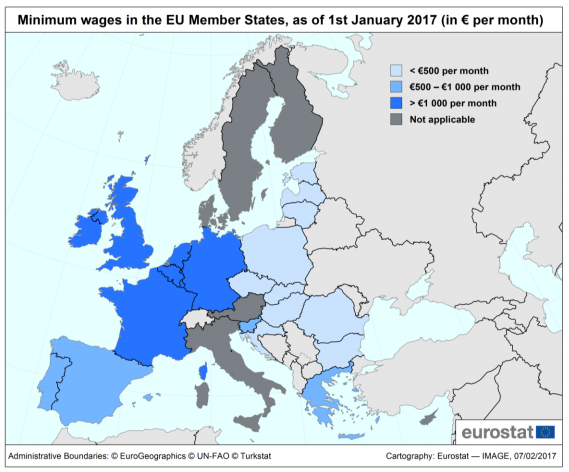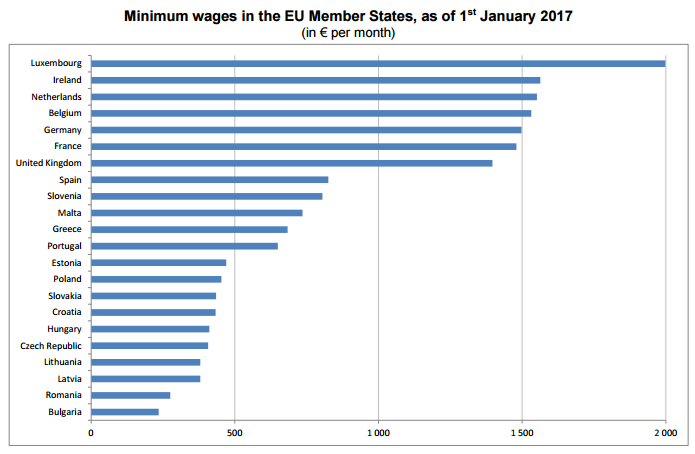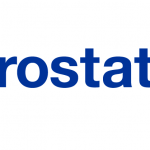These are the minimum wages in European countries

Monthly minimum wages below €500 in east and well above €1000 in northwest
As of 1st January 2017, 22 out of the 28 Member States of the European Union (EU) have national minimum wages: only Denmark, Italy, Cyprus, Austria, Finland and Sweden do not have one. The 22 EU Member States that have national minimum wages can be divided into three main groups based on the level in euro.
In January 2017, ten Member States, located in the east of the EU, had minimum wages below €500 per month: Bulgaria (€235), Romania (€275), Latvia and Lithuania (both €380), the Czech Republic (€407), Hungary (€412), Croatia (€433), Slovakia (€435), Poland (€453) and Estonia (€470).
In five other Member States, located in the south, minimum wages were between €500 and €1 000 per month: Portugal (€650), Greece (€684), Malta (€736), Slovenia (€805) and Spain (€826).
In the remaining seven Member States, all located in the west and north of the EU, minimum wages were well above €1 000 per month: the United Kingdom (€1 397), France (€1 480), Germany (€1 498), Belgium (€1 532), the Netherlands (€1 552), Ireland (€1 563) and Luxembourg (€1 999).
For comparison, the federal minimum wage in the United States was €1 192 per month in January 2017.
This information comes from an article issued by Eurostat, the statistical office of the European Union.

Gap reduced from 1 to 9 in euro to 1 to 3 when minimum wages are expressed in PPS
Across the 22 Member States concerned, minimum wages range from less than 300 euros per month in both Bulgaria (€235) and Romania (€275) to just below 2 000 euros a month in Luxembourg (€1 999). In other words, the highest minimum wage in the EU is around 9 times the lowest.

However, the disparities in minimum wages across the EU States are considerably smaller once price level differences are eliminated: minimum wages in those Member States with relatively lower price levels become mrelatively higher when expressed in purchasing power standard (PPS), and relatively lower in those Member States with higher price levels. The gap is reduced to a ratio of about 1:3, ranging from 501 PPS per month in Bulgaria to 1 659 PPS in Luxembourg.
Minimum wages closest to median earnings in Portugal, France and Slovenia
Minimum wages may also be measured in relative terms, i.e. as a proportion of the median gross monthly earnings. In 2014, among Member States concerned and for which data on median earnings are available, minimum wages were above 60% of the median gross monthly earnings in only three Member States: Portugal (64%), France and Slovenia (both 62%). In contrast, minimum wages were less than half of the median earnings in seven Member States: the Czech Republic (39%), Estonia (40%), Ireland and Spain (both 45%), Slovakia (46%), Malta (48%) and the United Kingdom (49%).
Minimum wages decreased compared with 2008 only in Greece
Compared with 2008, minimum wages in 2017, expressed in euro, increased in every Member State having a national minimum wage, except Greece where they dropped by 14%. Between 2008 and 2017, minimum wages doubled in Bulgaria (+109%) and Romania (+99%). In addition, Slovakia (+80%) as well as the three EU Baltic Member States – Estonia (+69%), Latvia (+65%) and Lithuania (+64%) – also recorded significant increases.
For Methods and Definitions, click HERE
Source: Eurostat





























